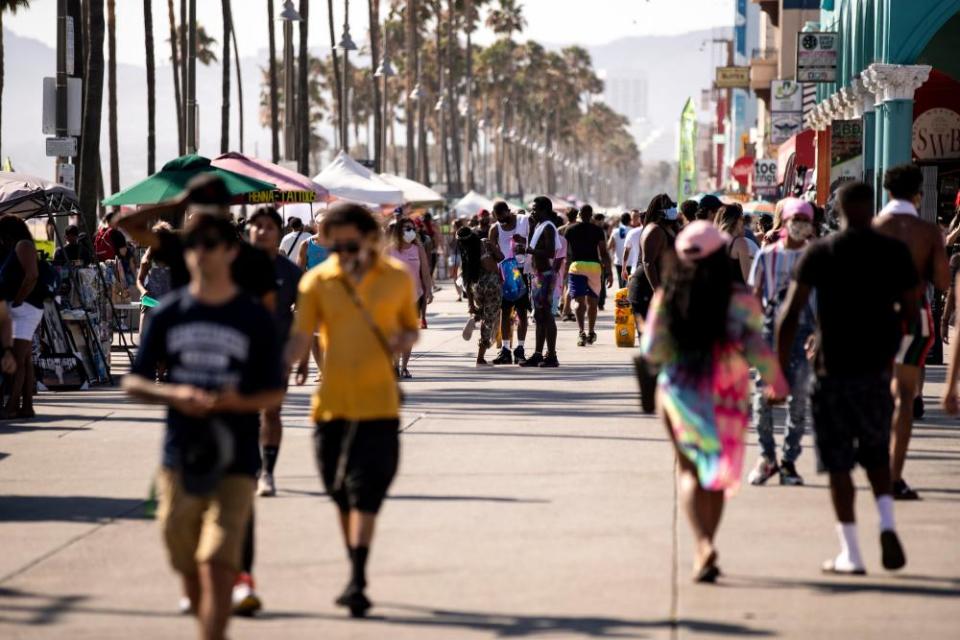California orders closure of bars and indoor operations of restaurants and theaters
California’s governor has ordered all bars to close statewide and all restaurants, movie theaters and museums to halt indoor operations, in a dramatic rolling back of reopening efforts as coronavirus cases continue to surge.
In addition to the statewide closures, the 30 counties on the state’s monitoring list must also shut down indoor operations at places of worship, fitness centers, hair salons, barbershops and malls.
California is contending with a rapidly growing caseload; the state has seen an average of 8,211 daily cases over the past week, an uptick from the 7,876 average from the week before. The positivity rate has increased to 7.4%, up from 6.1% a few weeks prior.
“It’s incumbent on all of us to recognize, soberly, that Covid-19 is not going away anytime soon,” said Gavin Newsom, California’s governor.
Related: 'This is a war': the coronavirus disaster in California's hardest-hit – and poorest – county
“We were able to suppress the spread of this virus. We were able to knock down the growth of this at the beginning. We’re going to do that again,” Newsom said. “There’s no doubt in my mind. But at the same time, that can’t happen without demanding something of you,” he added, urging people to continue to wear masks and observe physical distancing.
In total, California has reported more than 320,000 cases and 7,017 deaths. In the last 24 hours alone, 23 people have died from coronavirus, Newsom said.
The move comes as cases nationwide top 3.3m, according to Johns Hopkins University’s tracker, meaning the country now accounts for about a quarter of all cases worldwide. More than 135,000 Americans have died of coronavirus. Florida, another state experiencing a major surge, reported 15,299 new cases on Sunday – the largest single-day rise of any state so far.
Donald Trump continues to downplay the crisis and undermine public health experts, blaming the rising numbers on increased testing. On Monday the US president retweeted a claim that the Centers for Disease Control and Prevention is “lying” about coronavirus.
Last week California experienced its two deadliest days since the start of the pandemic, marking a particularly difficult period for a state that had been widely applauded for its early action in stemming the spread.
Newsom’s announcement on Monday came two weeks after he called for a similar shutdown for 19 of the state’s hardest-hit counties, an order that affected 70% or the state’s population. There are now 30 counties on the state’s “watch list” – regions where coronavirus is getting worse – prompting authorities to stall reopening statewide.

The move comes as California’s two largest school districts, Los Angeles and San Diego, announced classes would remain online-only throughout the fall semester. Trump responded to the announcement, saying he believed “schools should be opened”. “You’re losing a lot of lives by keeping things closed,” he said.
Newsom joins governors across the country who are rolling back reopening efforts. Earlier this month, Doug Ducey, Arizona’s governor, and Greg Abbott, Texas’s governor, ordered bars, nightclubs, gyms, movie theaters and water parks to close in their states. Abbott went a step further and ordered that residents wear masks in public, as Newsom has required Californians to do since mid-June. Meanwhile, Andrew Cuomo, New York’s governor, announced on Monday that travelers coming from states with high levels of coronavirus spread must now provide their contact information to officials.
Public health officials have narrowed down the sources behind the surges in each individual county, which are varied in demographics, industry and landscape.
Los Angeles county, whose population makes up more than a quarter of the entire state, has been home to the largest number of coronavirus cases since the pandemic began, with public health officials attributing this in part to high levels of testing. Marin county, an affluent, mostly suburban county north of San Francisco, is experiencing elevated transmission and increased hospitalizations in part due to an outbreak at San Quentin state prison. Meanwhile, Imperial county, a small southern block of desert bordering Arizona with a population of 181,000, has seen an elevated transmission rate possibly linked to residents traveling to and from Mexico for work and healthcare, as well as from an outbreak at a meatpacking facility.

